A blank page. A blinking cursor. Text: right-aligned. Font: courier new. FADE IN: Every movie, and therefore every screenplay, has transitions.
Every change in time is a transition; every scene change is a transition; every change in location is a transition. Good use of transitions makes a screenplay easier to read and conveys a stronger vision overall. Bad use of transitions can make the screenplay illegible and difficult to see what the story will actually look like on screen.
But how do you utilize screenplay transitions within your work? And what are the key ones you MUST know before you start writing? This article will clarify how, why, and WHEN to use every type of screenplay transition, with examples from some of the most successful screenwriters and screenplays.
Table of Contents
- The History of Screenplay Transitions
- Screenplay Transitions Are a Storytelling Tool
- What Are the Different KEY Screenplay Transitions?
- 1. BACK TO:
- 2. CUT TO:
- 3. DISSOLVE TO:
- 4. FADE IN/OUT:
- 5. FLASH CUT TO:
- 6. FREEZE FRAME:
- 7. IRIS IN/OUT:
- 8. MATCH CUT TO:
- 9. MATCH DISSOLVE TO:
- 10. SMASH CUT TO:
- 11. TIME CUT TO:
- 12. WIPE TO:
- How Should You Use Screenplay Transitions?
The History of Screenplay Transitions
The use of screenplay transitions has developed alongside progress in filmmaking technology, as a wider scope required greater direction.
The art form of the motion picture, in the early twentieth century, relied on the powerful relationship between creativity and technology. Screenplay transitions were born out of this, as writers kept up with developments in filming and editing.
1902’s iconic A Trip to the Moon, for example, is among the earliest examples of text describing characters, action, and location.
Early film writers borrowed from playwriting terms such as ENTER, STAGE LEFT, STAGE RIGHT, and EXIT for the framework of relaying movement and action on a page. However, screenwriting quickly became a new and exciting form with its own possibilities.
The shape of a story could be further molded and crafted in how scenes moved between one another. So creative and impactful screenplay transitions were required.
Screenplay Transitions Are a Storytelling Tool
A screenwriter must tell their story as effectively as possible, and screenplay transitions should be understood as a powerful way to do just that.
Everything a writer does should service the story, and something seemingly as simple as transitions are no different.
An effective screenplay transition can add to a script’s tone, mood, and character, and helps translate exactly what is in the writer’s mind onto the page.
The correct use of screenplay transitions also demonstrates a writer’s professionalism and experience. Like proper margins and formatting, using screenplay transitions correctly can separate an inexperienced writer from one who might write something which could sell. Effective transitions are just another way to signal that your screenplay is industry-ready and that, in turn, you as a writer are industry-ready.
Considering all this, it is worth taking the time to get familiar with key screenplay transitions. Reading scripts and watching films whilst paying close attention to how scenes move from one to the next is important. But on top of that, knowing how these transitions break down in a screenplay is vital knowledge to have before wading into writing a screenplay.
What Are the Different KEY Screenplay Transitions?
So what screenplay transitions must you know? Let’s look at 12 core screenplay transitions.
1. BACK TO:
Here’s an example of Judd Apatow writing ‘BACK TO SCENE’ in The Forty-Year-Old Virgin.
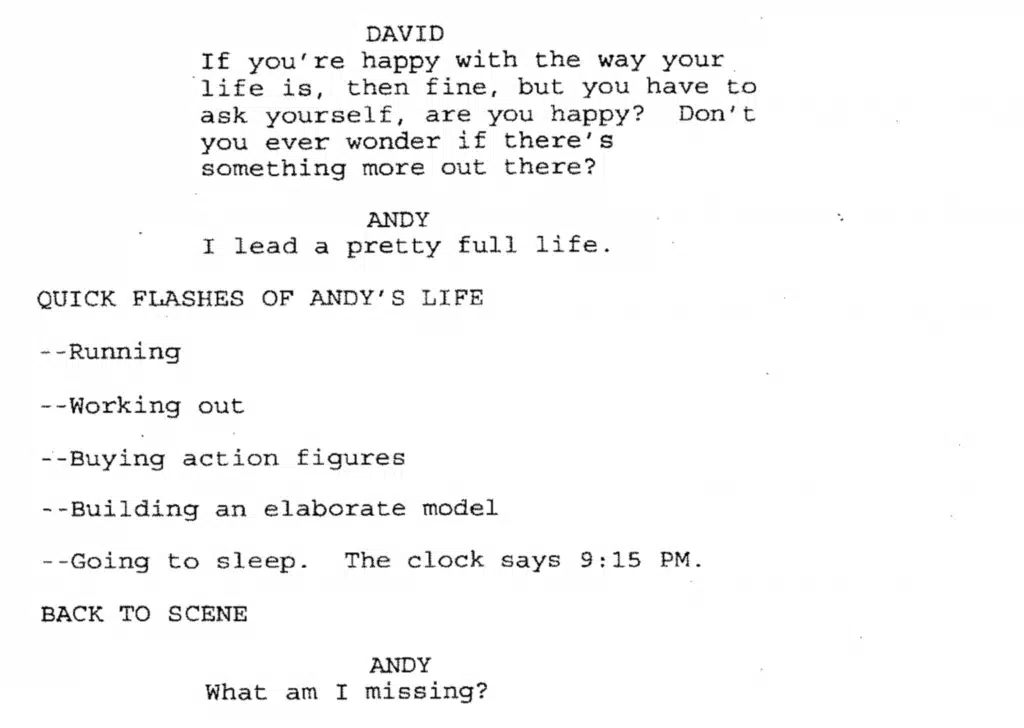
The punchiness here is integral to the comedy of the scene. A different, less deliberate screenplay transition might not have the same bold ironic effect. So ‘BACK TO SCENE’ can snap the audience back to the present action from a flashback or cut to somewhere else with clarity.
2. CUT TO:
The classic. A quick cut over the course of one frame. One scene ends and another is on the screen immediately. No frills. This is the most simple and common screenplay transition.
Greta Gerwig, for example, uses a simple ‘CUT TO’ in this poignant moment in Ladybird. All that is needed is this simple, to-the-point screenplay transition.
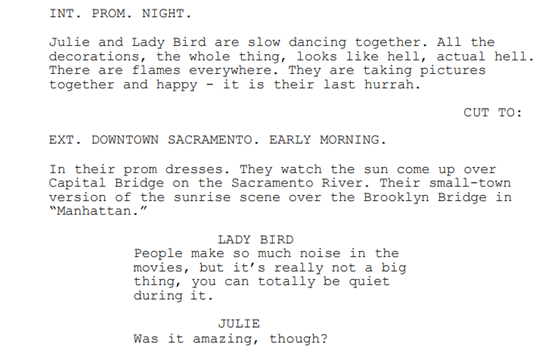
3. DISSOLVE TO:
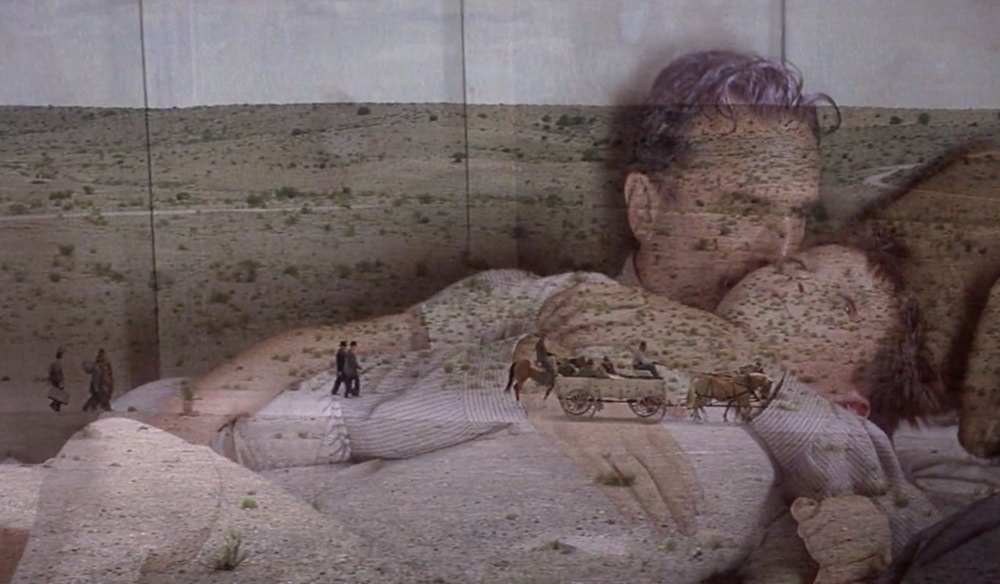
One scene fades out and another fades into its place, with a brief crossover merging the two images.
One effect this can have – probably the most common – is showing the passage of time.
The Godfather, for example, is full of this trick; Francis Ford Coppola and Mario Puzo’s use of patient and slow dissolves makes the story feel epic and long, with an undercurrent of melancholy and pensiveness throughout.

An alternate and more thematic, intangible effect of the dissolve screenplay transition is how it links scenes to each other. The audience interprets connective tissue when images run onto one another. More on this later when discussing ‘MATCH DISSOLVE TO’.
4. FADE IN/OUT:
Used at the start and end of a screenplay to indicate the story beginning and closing. Their use is practically symbolic now, even if the film won’t necessarily begin with a fade.
However, sometimes the use of a ‘FADE IN’ can help ease the audience into a new world with slow subtlety.
For example, here’s the iconic first time Lily and Lana Wachowski invited audiences to enter the world of The Matrix. It all begins with fading in…

We go from darkness into a frantic cacophony of computer text, slowly entering this strange new world. Notably, the transition is built upon by the fantastic and fluid description. But still, the’ FADE IN’ is important in getting us there.
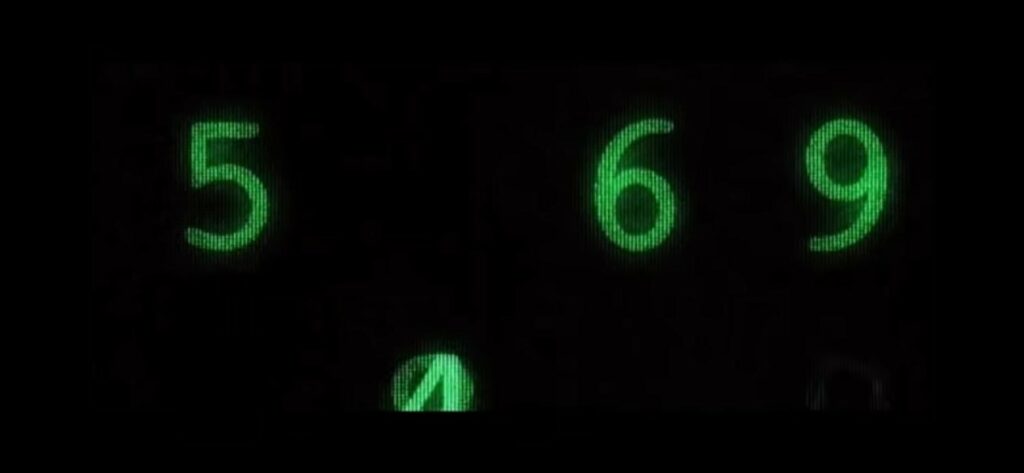
5. FLASH CUT TO:
A flash of an image on screen which can be as short as a single frame, or as long as a small scene.
Here’s how the Daniels use it in their screenplay for Everything Everywhere All At Once, followed by their own version of a ‘BACK TO’ transition:
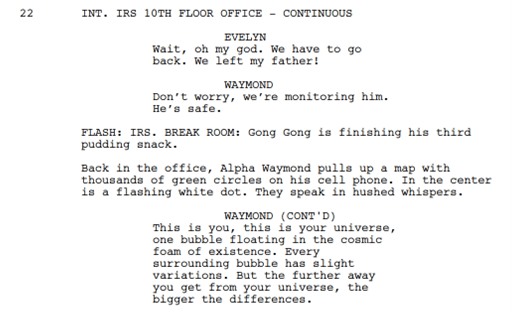
Flash cuts are similar to intercuts, or cutaways. The above is of course a comedic example, but this specific screenplay transition is also common in horror, containing violent images in these short flashes.
6. FREEZE FRAME:
A ‘FREEZE FRAME’ is when all the motion stops suddenly, and the video on screen becomes, effectively, a still image. Think about how it was used to rather cheesy effect in 80s films, such as The Breakfast Club.
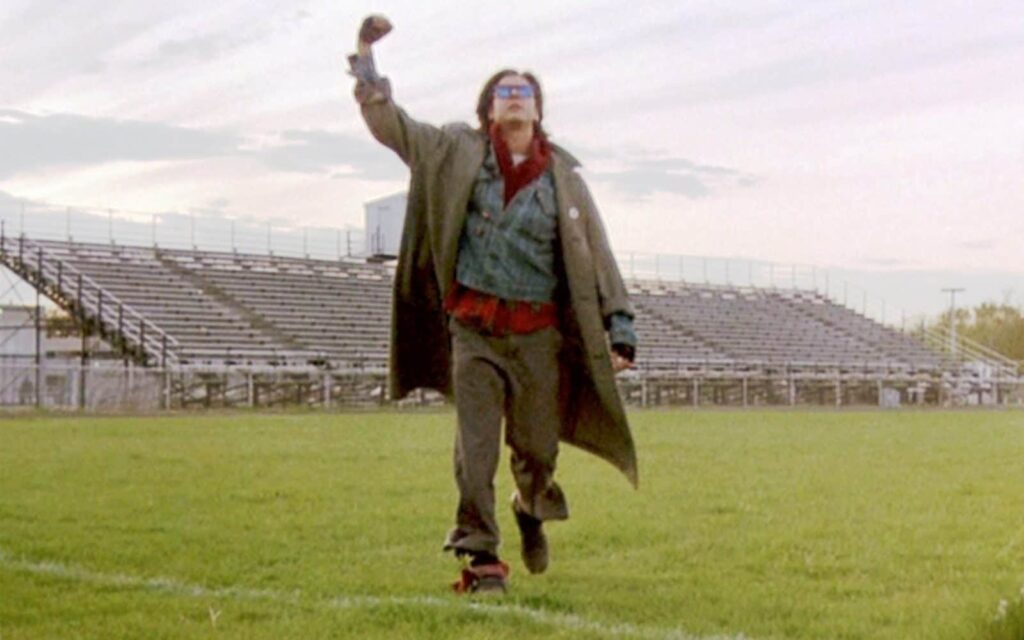
There’s also the stereotypical ‘FREEZE FRAME’ introduction, designed to grab an audience’s attention.
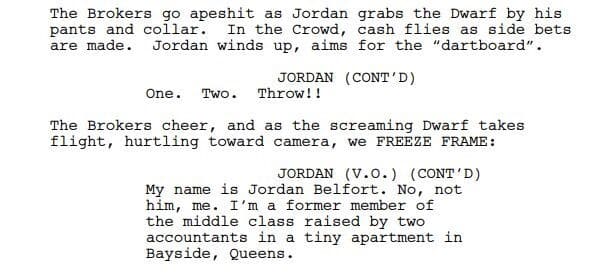
In the above, Terence Winter uses a ‘FREEZE FRAME’ transition to evoke the era of The Wolf of Wall Street as well as capture a shocking moment and squeeze it for all its worth.
These are probably the most common uses of the ‘FREEZE FRAME’ screenplay transition, but it is not limited to dramatic endings/openings only. A freeze frame is a stylistic storytelling device that can make easily make a screenplay stand out if used well. It can stop the audience in their tracks, pulling focus from a specific moment for a specific reason.
7. IRIS IN/OUT:

An old-school one.
Wiping from one point in the image outwards in every direction, somewhat mirroring what an eye would see as it opens. This is rarely seen (especially nowadays) and such a big decision on the look of a piece might best be left to the director and/or editor.
However, if you have a strong stylistic vision for the script and the ‘IRIS IN/OUT’ pertains strongly to the story and its themes, it can be a striking scene transition.
8. MATCH CUT TO:
Transitions don’t get much more famous than when Stanley Kubrick summarised all of humanity’s technological progress in a single moment. That is the potential power of film, and the blueprints of this kind of ambition can be in the screenplay.

The ‘MATCH CUT’ stitches together two scenes that both share a similar image.
- This is done with a certain shape in the case of 2001: A Space Odyssey.
- Or it’s also done, for example, with color in Lawrence of Arabia.
This can be done for thematic purposes, making clear and prominent connections across your screenplay that a reader might miss. A good ‘MATCH CUT’ might underline a certain point when used in a screenplay.
A writer should make use of every tool possible as film is after all a visual medium. Cuts like this might be found in an edit. But in writing, matching scene transitions at important moments in the story will help heighten the impact of certain beats and give your screenplay an appealing cinematic fluidity.
9. MATCH DISSOLVE TO:
This is a combination of the ‘MATCH CUT TO’ and ‘DISSOLVE TO’ screenplay transitions. It blurs a previous scene into the next, centering around, at least partly, a similar image.
The end of The Favourite offers a prime modern example of this sometimes overwhelming and powerful storytelling tool. Match-dissolving connects multiple images with one another, confronting the audience with the film’s message directly but also adding to the surrealist tone of the film overall.
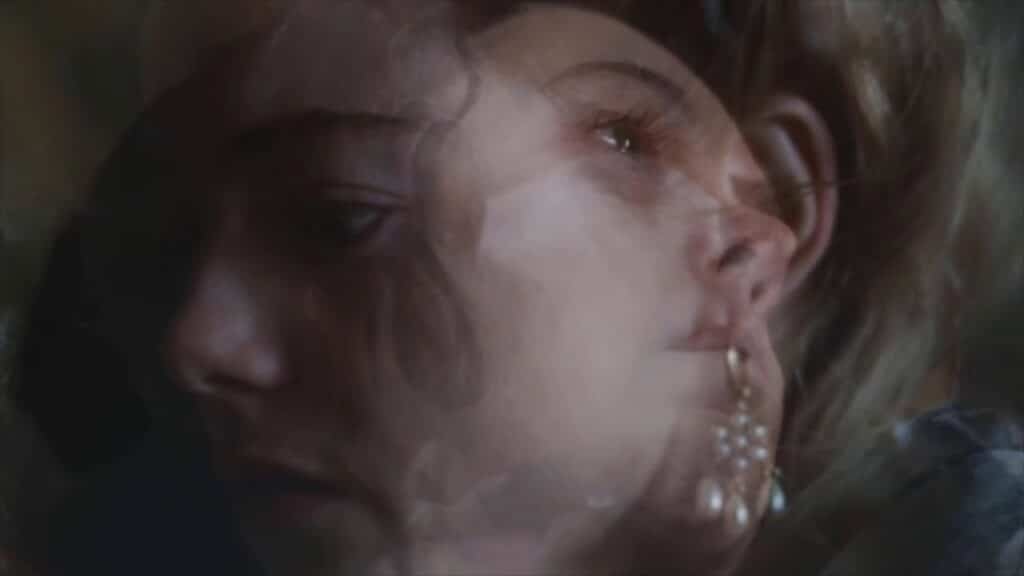
10. SMASH CUT TO:
‘SMASH CUT TO’ has a very simple purpose; it is a more aggressive, pointed version of ‘CUT TO’.
If a writer wants to exaggerate contrast in their screenplay when a quiet scene transitions to a loud one, or a violent one to a peaceful one, they might use ‘SMASH CUT TO’ or ‘SMASH TO’ to make this extremely clear to the reader. It is all about telling the story clearly.
This example from The Bourne Ultimatum, for instance, throws us right into the action.

11. TIME CUT TO:
The passage of time without changing location. This is a simple storytelling device to show something changing over a period of time, be it minutes or years.
This screenplay transition is often used to exaggerate. It is common, for example, to see it used when someone is waiting for another person who is running late/doesn’t arrive.
The cut not only transitions us from one period of time to another in a short time but also can convey something of the tone and mood. If a character has been waiting in one location for a long time, seeing the time transition can show us how frustrated and bored they are, staying still whilst everything changes around them, for example.
12. WIPE TO:
A new image overtakes the screen from the previous scene. The most famous examples are all from Star Wars which is synonymous with this fun, retro transition.

It’s not a particularly common transition but could be used to convey a retro feel or a specific style.
How Should You Use Screenplay Transitions?
There are a lot of contentious points when it comes to screenplay formatting and no set ‘rule of thumb’. Should you bold your sluglines? Should you ever say ‘we see’ in a script? What about describing camera movements?
Nobody has a definitive answer to these questions (despite what they might tell you). Screenplay transitions are no different – there’s a lot of room for disagreement when it comes to which to use, which not to use, and when.
The most important rule to remember when it comes to screenplay transitions is that you needn’t write ‘CUT TO’ between each scene. It’s implied.
Instead, screenplay transitions should be wielded sparingly and for impact at specific points of the screenplay. When thinking of how to move from scene to scene, ask yourself, can I ADD to the story?
This balancing act between a screenplay being a blueprint and an engaging read can be difficult at times, but luckily screenplay transitions are a way of maintaining control. They evoke images and enhance themes and pace.
A screenplay without varied transitions might lack cinematic value, but too many might clog things up and be distracting. So understand screenplay transitions as a tool to deploy carefully and thoughtfully, not just for the sake of it. They’re not a strict instruction but a stylistic indicator, a tone-setter, and something to help make the story more fluid and impactful as a visual piece.
- What did you think of this article? Share it, Like it, give it a rating, and let us know your thoughts in the comments box further down…
- Struggling with a script? Story analysis is what we do, all day, every day…check out our range of script coverage services for writers and filmmakers.
This article was written by Henry Spicer and edited by IS Staff.
Get *ALL* our FREE Resources
Tackle the trickiest areas of screenwriting with our exclusive eBooks. Get all our FREE resources when you join 60,000 filmmakers on our mailing list!

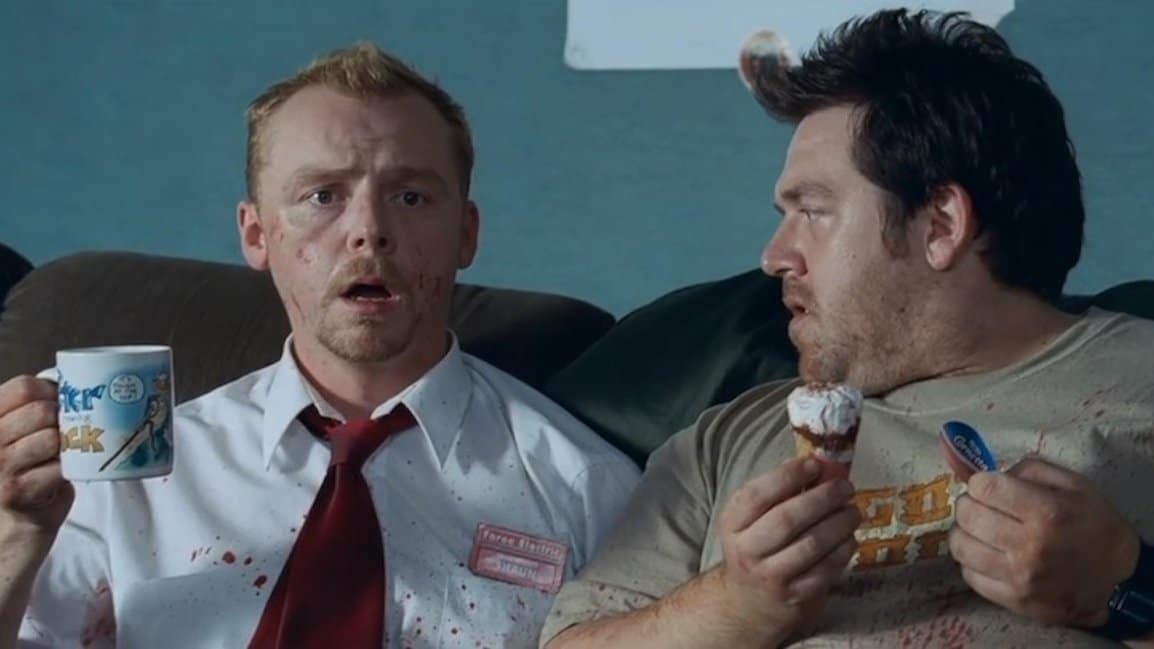
Good refresh on transitions. Helpful as well.
Article on Transitions was very helpful!